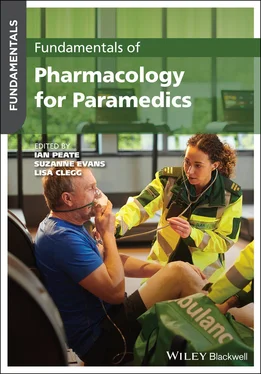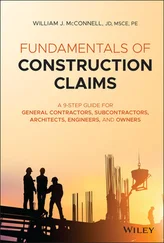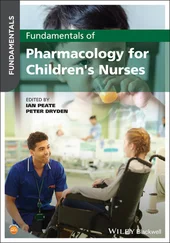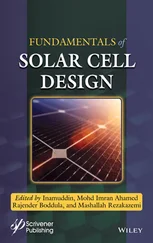1 Cover
2 Dedication Page To all those health professionals who have put themselves in harm’s way to care for patients in the front lines of the COVID‐19 pandemic.
3 Title Page
4 Copyright Page
5 Contributors
6 Preface
7 Acknowledgements
8 Prefixes, suffixes and abbreviations Abbreviations used in prescriptions
9 Chapter 1: Introduction to pharmacology Aim Naming and classifying drugs How drugs bring about their actions How are we able to manipulate physiological function using drugs? Receptors as sites of drug action Enzymes as sites of drug action Ion channels Transport molecules Selectivity of binding and its effect The drug–body interaction is a dynamic process Conclusion Glossary References Further reading Multiple‐choice questions
10 Chapter 2: How to use pharmaceutical and prescribing reference guides Aim Introduction HCPC Standards of conduct, performance and ethics HCPC Standards of proficiency for paramedics Joint Royal Colleges Ambulance Liaison Committee (JRCALC) Clinical Practice Guidelines Useful additional resources Conclusion Disclaimer References Further reading Multiple‐choice questions
11 Chapter 3: Legal and ethical issues Aim Introduction The law Ethical principles and theories Regulatory bodies Research Conclusion Glossary References Further reading Multiple‐choice questions
12 Chapter 4: Medicines management and the role of the paramedic Aim Introduction Medicines management Manufacturing, marketing, procurement and sale Selection Supply Prescribing Handling and administration Medicines optimisation Storage and disposal Conclusion References Further reading Multiple‐choice questions
13 Chapter 5: Pharmacodynamics and pharmacokinetics Aim Introduction Pharmacokinetics Pharmacodynamics Conclusion References Further reading Multiple‐choice questions
14 Chapter 6: Drug formulations Aim Introduction Routes of drug administration Formulations Conclusion Glossary References Further reading Multiple‐choice questions
15 Chapter 7: Adverse drug reactions Aim What is an adverse drug reaction? Classification of adverse drug reactions How prevalent are adverse drug reactions? Who is more likely to experience adverse drug reactions? Recognising signs and symptoms of adverse drug reactions Preventing adverse drug reactions Managing adverse drug reactions Reporting adverse drug reactions Conclusion References Further reading Multiple‐choice questions
16 Chapter 8: Analgesics Aim Pain and analgesia Types of pain Assessment of pain Approach to analgesia Antagonists Adjuncts to analgesia Conclusion Glossary References Further reading Multiple‐choice questions
17 Chapter 9: Antibacterials Aim Introduction Language and terminology Antibacterial mechanisms of action Choosing the right treatment Antimicrobial resistance Antibacterials by clinical use Conclusion References Further reading Multiple‐choice questions
18 Chapter 10: Medications used in the cardiovascular system Aim Cardiovascular diseases Hypertension and heart failure Acute coronary Syndrome (ACS) Conclusion Glossary References Further reading Multiple‐choice questions
19 Chapter 11: Medications used in the renal system Aim Introduction Acute kidney injury Chronic kidney disease Electrolyte abnormalities resulting from poor renal function Urinary retention and incontinence Drug‐induced renal damage Drugs that act on the renal system Conclusion Glossary References Further reading Multiple‐choice questions
20 Chapter 12: Medications and diabetes mellitus Aim Introduction Hormonal control of blood glucose Monitoring diabetes Drug use in diabetes Drug use in diabetic emergencies Conclusion Glossary References Multiple‐choice questions
21 Chapter 13: Medications used in the respiratory system Aim Introduction Anatomy and physiology Common respiratory emergencies Classes of medications Medical gases Conclusion Find out more References Further reading Multiple‐choice questions
22 Chapter 14: Medications used in the gastrointestinal system Aim Introduction Anatomy and physiology of the gastrointestinal system Nausea and vomiting Peptic ulcers Constipation Gastro‐oesophageal reflux disease Inflammatory bowel disease (IBD) Conclusion References Multiple‐choice questions
23 Chapter 15: Medication and the nervous system Aim Introduction The nervous system Parkinson disease and parkinsonism Dementia Cautions Epilepsy Strokes (including transient ischaemic attacks) Conclusion References Further reading/resources Multiple‐choice questions
24 Chapter 16: Medications used in mental health Aim Introduction Neurotransmitters Antidepressants Anxiolytics Hypnotics Mood‐stabilising medications Antipsychotics Dementia Attention deficit‐hyperactivity disorder Conclusion Find out more about these conditions Glossary References Further reading Resources Multiple‐choice questions
25 Chapter 17: Immunisations Aim Introduction Understanding the fundamental epidemiological concepts and theories in preventing infectious diseases Becoming familiar with vaccine design to underpin clinical practice knowledge Appreciating public concerns in the acceptability and uptake of immunisations Recognising the role of the paramedic in health promotion and immunisation administration Conclusion References Further reading Multiple‐choice questions
26 Normal Values
27 AnswersChapter 1 Introduction to pharmacology Chapter 2 How to use pharmaceutical and prescribing reference guides Chapter 3 Legal and Ethical Issues. Chapter 4 Medicines management and the role of the Paramedic Chapter 5 Pharmacodynamics and Pharmacokinetics Chapter 6 Drug Formulations Chapter 7 Adverse Drug Reactions Chapter 8 Analgesics Chapter 9 Antibacterials Chapter 10 Medications used in the cardiovascular system Chapter 11 Medications used in the renal system Chapter 12 Medications and diabetes mellitus Chapter 13 Medications used in the respiratory system Chapter 14 Medications used in the gastrointestinal system Chapter 15 Medication and the Nervous System Chapter 16 Medications used in Mental Health Chapter 17 Immunisations
28 Index
29 End User License Agreement
1 Chapter 1 Table 1.1 Categorisation of drugs based on clinical usage, general action o...
2 Chapter 2 Table 2.1 Examples of emergency conditions covered in section 3. Table 2.2 Examples of specific trauma emergency conditions and management c...
3 Chapter 4Table 4.1 The potential risks of missed medication.
4 Chapter 5Table 5.1 Four stages of pharmacokinetics.Table 5.2 Factors that affect absorption of drugs.Table 5.3 Examples of opioid by receptor binding.Table 5.4 Narrow therapeutic index examples.Table 5.5 Physiological changes in older patients and pregnant/lactating pa...
5 Chapter 7Table 7.1 Patient characteristics which predispose to adverse drug effects.Table 7.2 The most common causative medications, ranked by percentage of AD...Table 7.3 Adrenaline dosing guidance.
6 Chapter 8Table 8.1 Non‐pharmacological interventions to relieve distress and pain (T...Table 8.2 Physiological manifestations of pain.Table 8.3 Features of sensory nerve fibres.Table 8.4 FLACC Score.Table 8.5 Comparison of common non‐opioid analgesics.Table 8.6 Terminology for opioid receptors.Table 8.7 Pharmacokinetics of common opioids.
7 Chapter 9Table 9.1 Broad‐ and narrow‐spectrum antibiotics.Table 9.2 Pharmacokinetics of benzylpenicillin sodium.Table 9.3 Pharmacokinetics of cephalosporins.Table 9.4 Pharmacokinetics of imipenem.Table 9.5 Pharmacokinetics of tetracycline.Table 9.6 Pharmacokinetics of chloramphenicol.Table 9.7 Pharmacokinetics of aminoglycosides.Table 9.8 Pharmacokinetics of erythromycin.Table 9.9 Pharmacokinetics of clindamycin.
Читать дальше












